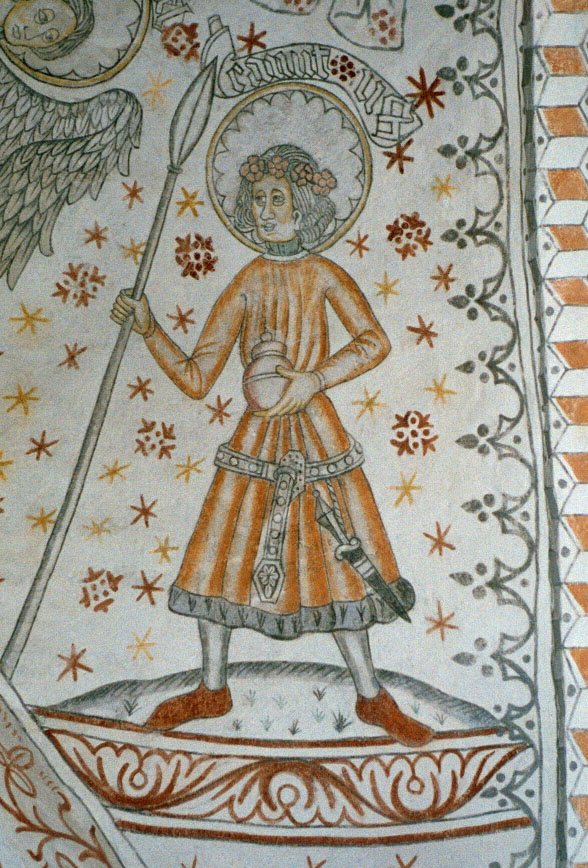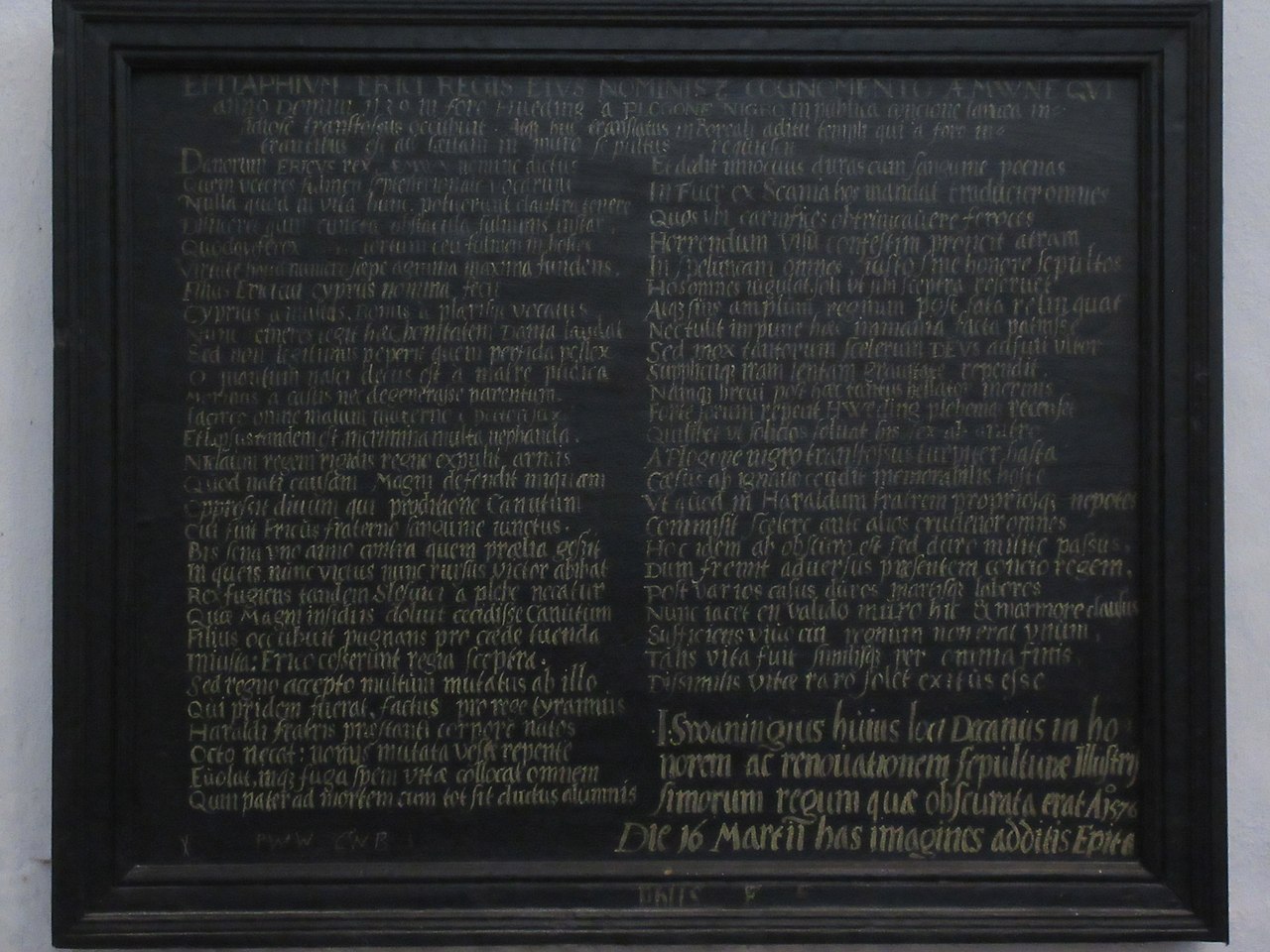by Susan Flantzer
© Unofficial Royalty 2025
Portrait of Eric II, King of Denmark, erected at his burial site, Ribe Cathedral in 1576; Credit – Wikipedia
Born circa 1090, Eric II reigned as King of Denmark from 1134 – 1137. He was an illegitimate son of Eric I, King of Denmark and an unknown concubine. He is also known as Eric Emune – Emune means “the always remembered”.

Eric II’s half-brother Saint Cnut Lavard, Duke of Schleswig; Credit – Wikipedia
Eric II had one half-brother from his father’s marriage to Bodil Thrugotsdatter, Queen Consort of Denmark:
- Saint Cnut Lavard, Duke of Schleswig (1096 – 1131), married Ingeborg of Kiev, had three daughters and one son, Valdemar I, King of Denmark. Cnut Lavard was canonized as a saint by the Roman Catholic Church in 1170.
Eric II’s father, Eric I, had several children born out of wedlock, who were Eric II’s half-siblings:
- Harald Kesja (1080 – 1135), married Ragnild Magnusdotter, daughter of King Magnus III of Norway, had six legitimate children and nine illegitimate children
- Benedict
- Ragnhilde, married Haakon Sunnivason, mother of King Eric III of Denmark

Painting by Danish history painter Niels Anker Lund (1840 – 1922) depicting the uproar caused when King Eric I announced his decision to go to the Holy Land; Credit – Wikipedia
When Eric II was around thirteen years old, his father, Eric I, King of Denmark, announced that he would go on a pilgrimage to the Holy Land. King Eric I and his wife Queen Bodil traveled with a large entourage via Novgorod, Russia, to Constantinople, then the capital of the Byzantine Empire, now the city of Istanbul in Turkey. In Constantinople, Eric I and Bodil were received by the Byzantine Emperor Alexios I Komnenos. However, Eric I never made it to the Holy Land. While in Constantinople, Eric I became ill, but despite his illness, he continued his travels by sea. On July 10, 1103, in Paphos, Cyprus, King Eric I of Denmark died and was buried in Cyprus. King Eric I had chosen Harald Kesja (1080 – 1135), one of his illegitimate children and Eric II’s half-brother, as his successor. However, when the nobles met, they chose Niels, the fifth of five illegitimate sons of Sweyn II Estridsson, King of Denmark who reigned as King of Denmark.

Eric II’s wife Malmfred of Kyiv, pictured on a stamp from Ukraine; Credit – Wikipedia
Around 1130, Eric II married Malmfred of Kyiv, the daughter of Grand Duke Mstislav I of Kyiv and Christina Ingesdotter of Sweden. Eric II and Malmfred had no children.
With his concubine Thunna, Eric II had one illegitimate son:
- Sweyn III Grathe, King of Denmark (circa 1125 – 1157), married Adela of Meissen, had one short-lived son and one daughter
In 1131, Eric II’s half-brother Cnut Lavard, Duke of Schleswig, was killed by their cousin Magnus, the son of King Niels, because Magnus saw Cnut Lavard as a rival to the Danish throne. The murder of Cnut Lavard started several years of civil war between King Niels and his son Magnus against Cnut Lavard’s illegitimate half-brother Eric Emune, the future Eric II, King of Denmark.
The civil war between the family members culminated on June 4, 1134, when the two sides fought the Battle of Fodevig near Lund in Scania, now in Sweden. The battle was a decisive victory for Eric Emune, who became the next King of Denmark as Eric II. His cousin Magnus was killed in battle, and his uncle King Niels fled to Schleswig, where the citizens avenged Cnut Lavard, their beloved Duke of Schleswig, by murdering Niels on June 25, 1134.
At a thing, an assembly of nobles, in Scania, Eric Emune was proclaimed Eric II, King of Denmark. He made Lund his capital city, and during his short reign, King Eric II lived in Lund, now in Sweden, but then part of Denmark.
Eric II started the canonization process of his half-brother Cnut Lavard by establishing Ringstead Abbey in the same Danish town as St. Bendt’s Church, where Cnut Lavard was buried. The monks at Ringstead Abbey were to document reports of miracles at Cnut Lavard’s grave. Eric II wanted to establish the divine right of kings in Denmark, and canonizing Cnut Lavard as a saint would support the claim of Eric II and his family to the Danish throne. Cnut Lavard was canonized as a saint, but not until 1170, thirty-three years after Eric II died.
To secure and keep power, Eric II treated his enemies cruelly, even his illegitimate half-brother Harald Kesja, whom Eric II saw as a threat. In 1135, Eric II had Harald Kesja and his eight surviving sons beheaded.
The Roskilde Chronicle describes King Eric II as a “rex tyrannus” – a tyrannical king – who spread terror wherever he went. The number of his enemies continually grew. Eskil, Bishop of Roskilde and the aristocrat Peder Bodilsen (link in Danish), formerly Eric II’s allies, but now his bitter enemies, began an unsuccessful rebellion. Just as Eric II was forcing Eskil, Bishop of Roskilde and Peder Bodilsen into a costly compromise, King Eric II was killed.
On September 18, 1137, in Umehoved, Denmark, a thing, an assembly of nobles, was held. A local nobleman, Sorte Plov (link in Danish), asked permission to approach King Eric II. Sorte Plov carried a spear with a piece of wood over the tip. After determining that Eric II had no armor under his clothing, Sorte Plov removed the wood from the spear’s tip and stabbed Eric II in revenge for the execution of a relative. Eric II’s nephew, Eric Haakonson, stepped forward with his mace. Eric Haakonson was the heir to the throne, and Sorte Plov pointed this out to him, saying, “Put away your mace, young Eric. A juicy piece of meat has fallen in your bowl!” Sorte Plov escaped with his life, and Eric II, King of Denmark was succeeded by his nephew Eric Haakonson, the son of Eric II’s sister Ragnhilde and Haakon Sunnivason, and reigned as Eric III, King of Denmark from 1137 – 1146.
Eric II, King of Denmark was buried at Ribe Cathedral in Ribe, Denmark. However, the cathedral has been rebuilt on several occasions. Although there are theories about where King Eric II was buried, no concrete evidence has emerged indicating where his grave may be. In 1576, a portrait of Eric II (at the beginning of this article) was erected at Ribe Cathedral accompanied by an epitaph (below), which is apparently quite unflattering.

Epitaph of King Eric II at Ribe Cathedral; Credit – By Oleryhlolsson – Own work, CC BY-SA 4.0, https://commons.wikimedia.org/w/index.php?curid=108681527
This article is the intellectual property of Unofficial Royalty and is NOT TO BE COPIED, EDITED, OR POSTED IN ANY FORM ON ANOTHER WEBSITE under any circumstances. It is permissible to use a link that directs to Unofficial Royalty.
Works Cited
- Bidragsydere til Wikimedia-projekter. (2003). Konge af Danmark (1090-1137). Wikipedia.org; Wikimedia Foundation, Inc. https://da.wikipedia.org/wiki/Erik_Emune
- Cathedral | Ribe Domkirke. (2024). Ribe-Domkirke.dk. https://doi.org/1068558.css?1736838294
- Flantzer, Susan. (2025). Eric I, King of Denmark. Unofficial Royalty. https://www.unofficialroyalty.com/eric-i-king-of-denmark/
- Wikipedia Contributors. (2024). Battle of Fotevik. Wikipedia; Wikimedia Foundation.
- Wikipedia Contributors. (2025). Canute Lavard. Wikipedia; Wikimedia Foundation.
- Wikipedia Contributors. (2025). Eric II of Denmark. Wikipedia; Wikimedia Foundation.
- Wikipedia Contributors. (2024). Harald Kesja. Wikipedia; Wikimedia Foundation.
- Wikipedia Contributors. (2024, November 4). Malmfred of Kiev. Wikipedia; Wikimedia Foundation.
- Wikipedia Contributors. (2025). Ribe Cathedral. Wikipedia; Wikimedia Foundation.
